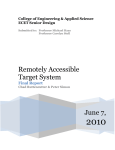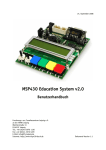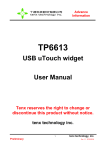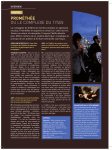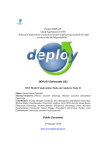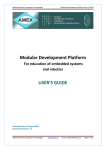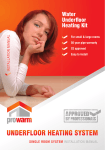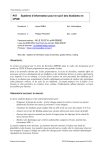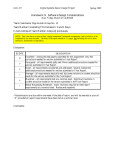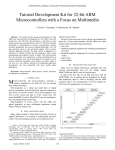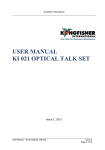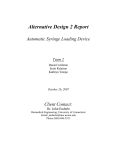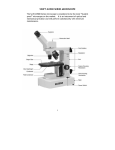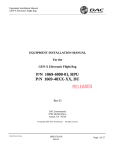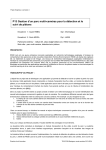Download Report - Machine Intelligence Lab
Transcript
EEL 4924 Electrical Engineering Design (Senior Design) Final Design Report 19 April 2011 Project Name: uTouch Team Members: Name: Issam Bouter Email: [email protected] Phone: 561-685-7455 Name: Constantine Metropulos Email: [email protected] Phone: 561-251-2170 Project Abstract: This project describes the functionality and building of a wireless touch pad universal controller with a full color LCD. The point of this is to give the user visual feedback, simple device navigation and to allow room functionality extensions. The functionality of the device includes several infrared interfaces to be used as a universal remote control for several household entertainment devices, a GUI with easy peripheral parameter settings, and the ability to use the device as a computer mouse, keyboard and shortcut remote through Bluetooth. University of Florida EEL 4924—Spring 2011 20-Apr-11 Electrical & Computer Engineering Page 2/13 Product Design Report: uTouch Table of Contents Product Features and Objectives ........................................................................................................ 3 Analysis of Competitive Products ..................................................................................................... 3 Concept and Technology Selection ................................................................................................... 4 Project Architecture ............................................................................................................................ 5 Division of Labor ................................................................................................................................ 7 User Manual ……................................................................................................................................ 8 Bill of Materials (BOM) .................................................................................................................... 13 Projected Timeline ............................................................................................................................. 13 List of Figures Figure 1: Apple Wireless Multi-Touch Pad ....................................................................................... 3 Figure 2: Samsung Multifunction Touchscreen Learning Remote .................................................... 4 Figure 3: Apple iPhone 4 (32-GB Model) ......................................................................................... 4 Figure 4: uTouch Detailed Functional Block Diagram ...................................................................... 5 Figure 5: LCD Driver Software Flowchart ........................................................................................ 6 Figure 6: Python Windows Computer Program Flowchart ................................................................ 7 Figure 7: MSP430F2272 Software Flowchart ................................................................................... 7 Figure 8: Picture of uTouch Device (Front) …................................................................................... 9 Figure 9: Picture of uTouch Device (Back) ....................................................................................... 9 Figure 10: Gantt Chart of Timeline ...................................................................................................10 Figure 11: Gantt Chart of Timeline ...................................................................................................10 Figure 12: Gantt Chart of Timeline ...................................................................................................11 Figure 13: Gantt Chart of Timeline ...................................................................................................11 Figure 14: Gantt Chart of Timeline ...................................................................................................12 Figure 15: Gantt Chart of Timeline ...................................................................................................12 Figure 16: Gantt Chart of Timeline ...................................................................................................12 Figure 17: Gantt Chart of Timeline ...................................................................................................13 List of Tables Table 1: Distribution of Labor ……………..……............................................................................. 6 Table 2: Bill of Materials (BOM) ……...…..……............................................................................. 8 University of Florida EEL 4924—Spring 2011 20-Apr-11 Electrical & Computer Engineering Page 3/13 Product Design Report: uTouch Product Features and Objectives: This project incorporates elements of both electrical and computer engineering and computer science design. The application domain for this project spans the areas of wireless communication, universal controllers, human interface technologies, microprocessor applications, and remote computer access and control. The main purpose of this project is to develop an efficient low-power wireless touch computer and infrared device controller using an LCD screen and a touch pad. This means that power consumption is important and was a key design limitation. The microprocessor selected needed to run at high enough speeds to communicate with multiple peripherals. For its exceptionally low power consumption and debugging flexibility, the MSP430F2272 was chosen. Size is also an important consideration, as this device is intended to be portable. Careful consideration was placed on final product size during the design, implementation, and construction of the system. The final uTouch device module measures approximately 4.25”x3.75”x1.25”, which is well under our aim of the largest size being 10”x7”x2”. With the Lithium Polymer batteries currently used, we are able to achieve a operation time of about 2 hours, which is about half of our initial desired time of four hours but with an upgrade from two 1000maH batteries to 2000maH batteries the operation time can approximately double. Analysis of Competitive Products: Currently the only comparable products in the commercial market are the Apple wireless multi-touch pad priced at $69.00 (shown in Figure 1 below), the Samsung Multifunction Touchscreen Learning Remote priced at $299.99 (shown in Figure 2 below), and the Apple iPhone 4 32GB model priced at $299.00 (shown in Figure 3 shown below). However, our product will differentiate itself from the all of these products by bridging the gap between them by controlling both infrared and Bluetooth devices. We hope to develop a GUI interface that will allow simple user interface with parameter setting and visual feedback. Even though the uTouch controller has the functionality of multiple commercially available products, it could be sold at an outstanding price of about $200. Figure 1: Apple Wireless Multi-Touch Pad University of Florida EEL 4924—Spring 2011 20-Apr-11 Electrical & Computer Engineering Page 4/13 Product Design Report: uTouch Figure 2: Samsung Multifunction Touchscreen Learning Remote Figure 3: Apple iPhone 4 32GB model Concept and Technology Selection: The main objective of our project was to build a complete intelligent remote control that could be used to control any Infrared device by learning infrared codes, and then transmitting the commands using a high-output infrared light emitting diode. Our main objectives were size, portability, usability, and low power consumption. We designed uTouch with these aspects in mind; carefully selecting appropriate parts that would lead to a complete final product. A 16-bit full-color touchscreen LCD was chosen for its compactness, moderate power usage, and versatility. This full-color touchscreen LCD allows uTouch to be presented to a user in an intuitive and easy to use manner. Since size, portability, and power were also main concerns, a large part of the design went into battery management. We chose to use two 1000mAh rated 3.7V Lithium Polymer batteries in series to meet our need for a power supply voltage over 5V. The voltage was designed to be a few volts over the needed 5V so that it could be regulated to a steady voltage and to lessen the impact of the battery discharge. This 2-cell Lithium Polymer battery pack is charged using a 2-Cell Lithium Polymer Battery Charging Integrated Circuit from Texas Instruments (BQ2057). The charging circuit functions in such a way as to charge the battery pack at a constant voltage with a temperature regulated trickle down current. The main concept is that the voltage across the battery pack stays the same, while the current is slowly decreased as the battery charges. An LED indicates the status of the charger, which automatically turns off when charging is complete. Another concern for building such a small compact unit was temperature, to take care of this aspect we incorporated a thermistor into the charging circuit to monitor the battery pack temperature and to suspend charging when higher temperatures are reached. The focal point of our IR learning and transmission was accomplished using an MSP430F2272. This chip was chosen for its built in modules and exceptionally low power consumption. A major obstacle was determining how to learn, permanently save, and then transmit an IR code. Learning the IR code was accomplished using a phototransistor and a custom built low pass amplifier circuit, and reading that output to the microprocessor through an Analog to Digital Convertor (ADC). An external SD Card was interfaced into the device in order to save a large number of IR codes while the device is functioning retain them when the device is not powered. In order to accomplish the storing and reading from an SD card, the SD protocol had to be studied and implemented. Once the IR code is read back into the MSP temporary storage, it is modulated and sent back out at between 38kHz and 40kHz (the standard is 38kHz, and nearly 85% of all IR devices use this range of modulation frequency). The LCD screen loads images from a micro SD card. Each image has regions of detection hardcoded in the LCD’s flash. The driver for the system is a PICASO-GFX2 processor that is coded in 4dgl, a proprietary programming language. The logic of the LCD screen is University of Florida EEL 4924—Spring 2011 20-Apr-11 Electrical & Computer Engineering Page 5/13 Product Design Report: uTouch state machine based. Each image is loaded and regions in the touchscreen cause different screens to be loaded or spi commands to be sent out. Some on the go graphics rendering happens for the mouse state, which gives the user some visual feedback. The LCD spi lines are connected to the Bluetooth device as well as the msp430. There is an identifier for each command that both the msp430 and the computer have to decipher and react accordingly. The baud rate of the Bluetooth is 115200 so each transmission to the computer happens very quickly. Project Architecture: The system level architectural block diagram in Figure 4 displays the overall connections and architecture of our system. The LCD driver PICASO-GFX2 controls the 16-bit full-color LCD screen to display the uTouch interface to the user. The flowcharts for the architecture and operation of this interface can be found in Figures 5. This figure shows the LCD driver chip software flowchart. The graphical displays that are presented to the user can be found in the User Manual section of the paper. The driver chip then processes the users commands via the resistive touchpad. From there, the driver chip will either control the Bluetooth module to communicate with the Python windows program, it will also send commands to the MSP430 F2272 microcontroller. The flowchart for the Python windows computer program can be found in Figure 6. The Python program consists of a Bluetooth driver, which interprets received commands into mouse, keyboard, and shortcut actions, alongside a GUI process which serializes user input to the hard drive and communicates it to the Bluetooth process through a cue. The MSP430 will then control the Infrared (IR) input and output, depending on the command received from the PICASO-GFX2 processor. The MSP continuously runs a main loop to check for flags set. When the learning flag is set, the MSP reads the IR input through an ADC channel from a custom designed low pass amplifier circuit using a phototransistor. The start of the IR code is found, and the following code is saved to ram in the MSP. The MSP then recognizes that there is a code waiting to be saved to the SD Card, and proceeds to save the code permanently on the external SD Card. Once the IR code has been saved to the memory card, the focus returns to the LCD driver, which will repeat its functionality previously described, or can also send the MSP a transmit command. When this transmit command is received, the MSP will read the IR code off of the external SD Card into onboard temporary memory, and will transmit the IR code through a high power IR LED. The flowchart of the MSP program functionality can be seen in Figure 7. University of Florida EEL 4924—Spring 2011 Electrical & Computer Engineering Page 6/13 Product Design Report: uTouch Figure 4: uTouch Detailed System Block Diagram Figure 5: LCD Driver Chip Software Flowchart 20-Apr-11 University of Florida EEL 4924—Spring 2011 Electrical & Computer Engineering Page 7/13 Product Design Report: uTouch Figure 6: Python Windows Computer Program Flowchart Figure 7: MSP430F2272 Software Flowchart 20-Apr-11 University of Florida EEL 4924—Spring 2011 20-Apr-11 Electrical & Computer Engineering Page 8/13 Product Design Report: uTouch Division of Labor: The following is a breakdown of each team member's projected labor by approximate percentage. Issam Bouter Constantine Metropulos Preliminary Research 50 50 Obtain Materials and Parts 50 50 Project Component Design 50 50 Color LCD & Touchpad System 90 10 Bluetooth Module 80 20 Computer Bluetooth Drivers & Software 80 20 Infrared Learning & Transmitting 20 80 Various Input Buttons & Devices 50 50 Battery Charging 20 80 System Integration 50 50 PCB Design & Construction 50 50 Test & Debug 50 50 Table 1: Distribution of Labor User Manual: The uTouch Universal Learning Remote Control is incased in a clear plastic case to allow the user to enjoy the technical aspect of the design. The clear case also allows for the secure placement of LEDs on the inside of the case, while still being visible from the outside. Pictures of the front of the uTouch controller, the side with the full-color LCD (Figure 8), and the back of device (Figure 9) give a general idea of the size and look of the device. The screen shown in Figure 8 is the Main Menu screen of the LCD controller that allows the user to choose which feature they would like to use. University of Florida EEL 4924—Spring 2011 20-Apr-11 Electrical & Computer Engineering Page 9/13 Product Design Report: uTouch Figure 8: Picture of uTouch Device (Front) Figure 9: Picture of uTouch Device (Back) The flow of the LCD software is described above in Figure 5, this flow determines which menu is displayed on the LCD screen for the user. The following figures are the completely list of menus available to the user. University of Florida EEL 4924—Spring 2011 Electrical & Computer Engineering Page 10/13 Product Design Report: uTouch Figure 10: TV Infrared controller screen. Each button can be programmed to learn an infrared code. Figure 11: Help screen. Describes the functionality of sections for the mouse interface state. 20-Apr-11 University of Florida EEL 4924—Spring 2011 20-Apr-11 Electrical & Computer Engineering Page 11/13 Product Design Report: uTouch Figure 12: Number Pad Infrared controller screen. Each button can be programmed to learn an infrared code. Figure 13: Mouse interface state. Changes of touch on this screen are sent to Bluetooth as a mouse change command. This has a menu button for personalizing this state, help button, shortcut buttons and the keyboard changes the state to the keyboard interface state. University of Florida EEL 4924—Spring 2011 Electrical & Computer Engineering Page 12/13 Product Design Report: uTouch Figure 14: Computer Infrared controller screen. Each button can be programmed to learn an infrared code. Figure 15: VCR Infrared controller screen. Each button can be programmed to learn an infrared code. Figure 16: DVD Infrared controller screen. Each button can be programmed to learn an infrared code. 20-Apr-11 University of Florida EEL 4924—Spring 2011 20-Apr-11 Electrical & Computer Engineering Page 13/13 Product Design Report: uTouch Bill of Materials (BOM): 2x Advanced Circuits PCB 2x RN-41 Bluetooth 2x TFT 3.2” LCD Various Capacitors and Resistors 741 Op Amp IR LED and phototransistor Enclosure SD Card and Housing Micro SD card TI BQ2057 Charging IC Misc. connectors, plugs and wires LED’s $66 $100 $180 $10 $1 $5 $11 $50 $35 Free Sample $30 $3 Gantt Chart / Project Schedule: The following figure (Figure 10) displays the project timeline for the completion of the project in the form of a Gantt Chart. Figure 17: Gantt Chart of Projected Timeline













